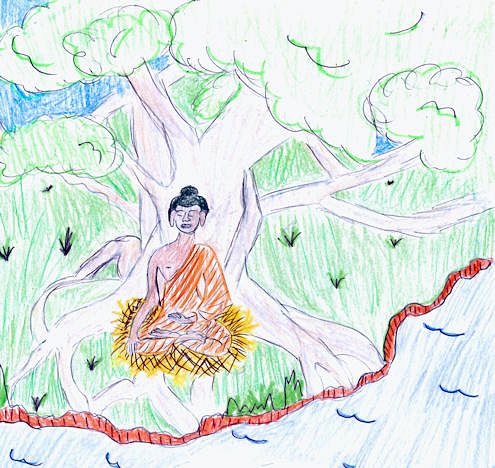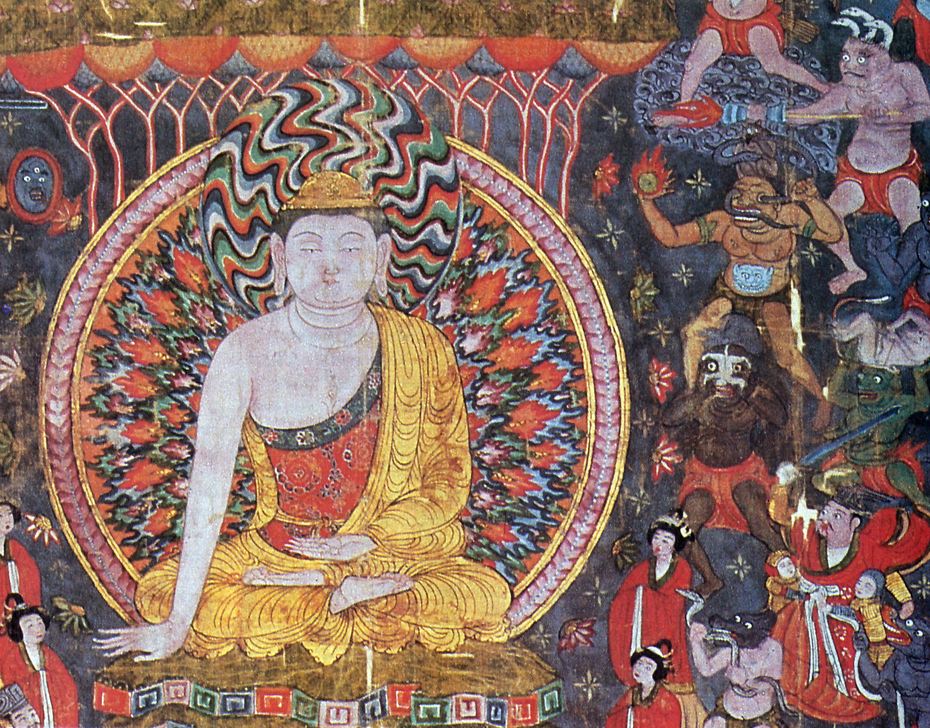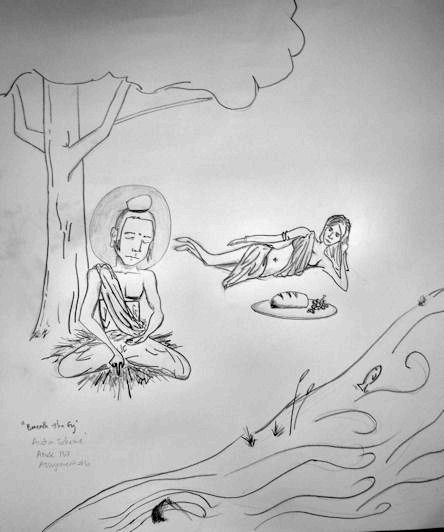
He sat upon the straw, facing east, resolved to discover the true principle and achieve the Great Awakening.
Drawing by Lauren Gretz, John Muir College (UCSD), by permission

In time, Siddhartha regained his former strength and beauty and looked once again as impressive as he had when he had lived in the palace. Each day an elegant lady named Sujata (Sujātā) brought him a tasty gruel made with milk as an act of merit. (She had no idea who he was, and some say that her maid had mistaken him for a local nature spirit.)
One day, after Siddhartha had bathed in the Nairanjana River, he went to sit and meditate beneath a shala tree on the river bank, the same kind of tree under which he had been born. He sat peacefully all day, but did not attain the Great Awakening. It is said by some that he cast his bowl into the river in discouragement, saying, “If I can be enlightened today, may the bowl float upstream.” To his surprise it did indeed float upstream, continuing until it was out of sight. In fact, it was sucked into a whirlpool, where it was carried deep beneath the earth to the lair of the serpent kings, where it landed atop a stack of other bowls sent up the same river by earlier buddhas when they too had been discouraged, for all buddhas have attained enlightenment beside this same river (although not under the same kind of tree).
That evening Siddhartha moved to the great fig (bodhi) tree in the Forest of Mortification that had bloomed there on the day of his birth and that destiny had already designated as the place of his enlightenment.

There he met a man carrying straw who gave him a sheaf of straw to sit upon as an act of merit. So he sat upon the straw, facing east, resolved not to arise until he had discovered the true principle and achieved the Great Awakening. (Modern Buddhists refer to this humble seat as the “diamond seat” or vajrā-sana, for upon this same spot all previous buddhas were also enlightened.)
As he sat, the demon Mara (Māra) the “Maker of Death” appeared with her fellow demons, hoping to prevent him from attaining enlightenment as he had prevented many before him and still prevents people today. Mara made visions of pleasures of the past appear before Siddhartha: the palace, the dancing girls, fine foods, and other luxuries, and he sent beautiful spirits to seduce him. When none of this worked, Mara argued that Siddhartha had no right to occupy the place where he sat.

In response, Siddhartha lowered his right hand so that the fingers pointed to the earth, and the earth goddess herself was witness to his religious accomplishment. Some people say that she caused the earth to quake. Others say that she wrung from her hair all the water that Siddhartha used in offerings to her in his many past lives, and the stream washed Mara away. (This is often portrayed in murals in Southeast Asia even today.)
He achieved consciousness of fate, and knew of his past lives and the cycle of birth and death.
He achieved consciousness of universal insight, and knew of past and present lives of all living things and of the laws of cause and effect governing all things.
He achieved consciousness of detachment that the answer to suffering was detachment from all desire.
And thus did Siddhartha of the Shakya tribe attain the Great Awakening seated beneath a fig tree under a full moon on the shores of the Nairanjana river and become a buddha, at the age of 35 years and six months and 15 days.

Once Siddhartha had become a buddha, not everyone was impressed, least of all other ascetics. What did they do? Read Part IV to find out.